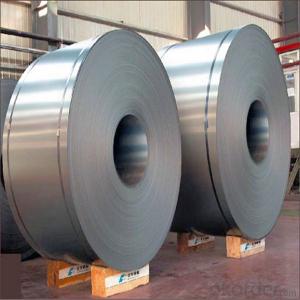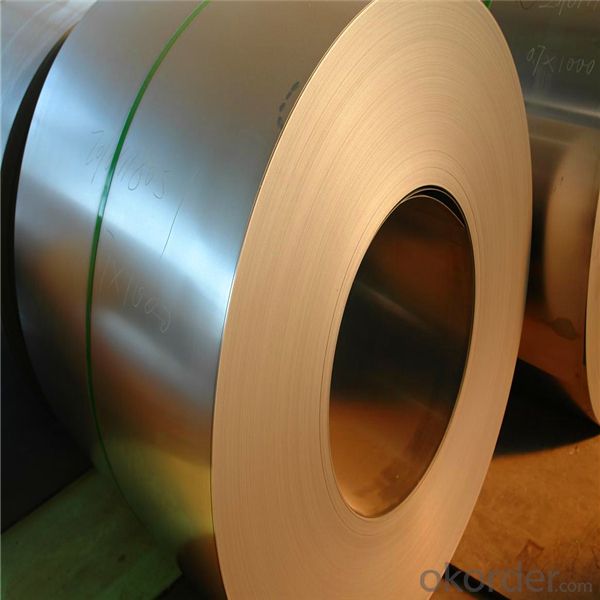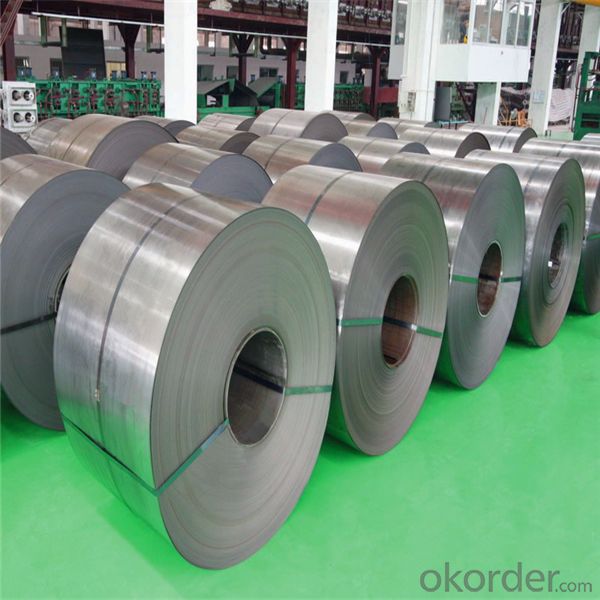Cold Rolled Steel Sheet in Coil/High Quality
- Loading Port:
- China main port
- Payment Terms:
- TT OR LC
- Min Order Qty:
- 10 m.t.
- Supply Capability:
- 10000 m.t./month
OKorder Service Pledge
Quality Product, Order Online Tracking, Timely Delivery
OKorder Financial Service
Credit Rating, Credit Services, Credit Purchasing
You Might Also Like
Item specifice
Standard:
AISI,JIS,GB,BS,DIN,API,EN,ASTM
Technique:
Cold Rolled
Shape:
Round
Surface Treatment:
Oiled
Steel Grade:
Q195,Q215,Q215B,Q235B
Certification:
ISO,SGS,BV,IBR,CE
Thickness:
0.18mm-1.8mm
Width:
1000mm-1600mm
Length:
requirement
Outer Diameter:
according to weight
Net Weight:
10MT
Packaging:
Standard Export Packing
Cold Rolled Steel Coil:
| With the professional produce line, we can manufacture the best quality with competitive price as below: | |
| Thickness: | 0.18mm-1.20mm |
| Coil width: | 600mm-1250mm |
| Coil weight: | 3.0-5.0MT |
| Surface finish : | 60-275g/m2 zinc coating and the customers requirment! |
| Steel grades: | Q195-Q345,GR.A,GR.B, SPCC,SPHC,DX51D, ECT. |
| Standard: | JIS G3302, JIS G3313, ASTM A653, GB/T2518-88, GB11253-89,ASTM A1008- 2000,BS,ETC. |
| Packing: | wrapped by plastic film and waterproof paper, and then fastened on wooden pallet. Used in building material field,Pipe making, furniture making,others |
| MOQ: | 50tons |
| Delivery times : | 20 days after received T/T or L/C |
| Payment terms : | T/T or L/C ( or as your demand) |
| Supply ability : | 6,000 ton per month |
| County we ever exported: Indonesia, Georgia, Mozambique, Somalia, Myanmar, Argentina,India,Dubai, and Turkmenistan. we can supply you the products you need with most competitive price and high quality. special size and standard can be accepted! PRODUCT PICTURE:
WHY CHOOSE US: We are professional in products export. We have established longterm cooperation with forwarders and shipping company. We have more than twenty overseas houseware with timely aftersale service. We have complicate and professional quality control system, from material purchasing to products loading abroad. | |
- Q:That's my question, well that and:Steel Pick + Electric Guitar = Trashed Guitar?:D
- That's not a question, it's a statement. And how would using any kind of pick trash a guitar? At worst it would harm a $5 set of strings, not the guitar.
- Q:Aluminum alloy rolling doors and color steel shutter door that good
- Among them, aluminum alloy rolling doors and ordinary rolling doors, both from the appearance, environmental protection or safety, have considerable advantages. Aluminum Alloy doors can be sprayed on the surface of various colors and patterns, but also with the concavity of the wood, sand grain coated, highlight the noble temperament, improve grades, if it is used in shops, you can let your talent shows itself in many shops in the.
- Q:I believe steel is stronger but it steel lighter than iron too?
- Steel is iron, with other things added that strengthen it and/or make it less rust liable. So, in general, steel is stronger than iron. In so far as the density, that depends on the steel alloy. Some are higher than iron, some lower. Remember there are hundreds of different steel alloys. edit: but the density is still close to that of iron. density steel 7750 to 8050 kg/m? density iron 7870 kg/m?
- Q:Can steel coils be customized in terms of size and specifications?
- Yes, steel coils can be customized in terms of size and specifications. Manufacturers have the ability to produce steel coils in various sizes and specifications to meet the specific requirements and needs of different industries and applications. This customization allows for greater flexibility and ensures that the steel coils can be used efficiently in different processes.
- Q:I need help my new stainless steel cookware is sticking ? My first meal was nasty!
- Food sticks to stainless steel. Gourmet cooks love it for that very reason. Without sticking, foods won't sear properly. For the rest of those cooks out there, nonstick is often an easier option. If you want to make a go of the stainless, here are some tricks of the trade.... a)always preheat the pan on low-medium b)never put cold food into a hot pan. It will stick worse.Leave cold food on counter for 15 minutes before it hits the pan. c)after preheating the pan, add oil, or an oil/butter combo d)for foods like eggs, potatos, grilled cheese, nonstick is your best friend. e) when you take food out of pan, immediately wipe the pan out with a kitchen towel. Keeps cleanup from being a nightmare. f) don't wash pans in sink while hot. They will warp. Stainless takes some getting used to. Hope this helps!
- Q:How do steel coils contribute to the energy efficiency of buildings?
- Steel coils contribute to the energy efficiency of buildings in several ways. Firstly, steel coils are often used in the construction of roofs and walls, providing a durable and well-insulated structure that helps to minimize heat transfer and reduce energy loss. Additionally, steel coils can be coated with reflective materials, such as cool roof coatings, which help to reflect the sun's heat and reduce the cooling load on the building. Lastly, steel coils are also commonly used in the manufacturing of HVAC systems, ensuring efficient heating and cooling operations, further enhancing the energy efficiency of buildings.
- Q:Can steel coils be transported by air?
- Yes, steel coils can be transported by air. However, it is important to note that the size and weight of the coils may limit the type of aircraft that can be used for transportation. Additionally, special equipment and packaging may be required to ensure the safe and secure transport of the coils.
- Q:How are steel coils used in the automotive industry?
- Steel coils are used in the automotive industry to manufacture various components such as car bodies, frames, and structural parts. The coils are first processed by being uncoiled, flattened, and then cut into the required shapes. These steel components provide strength, durability, and rigidity to vehicles, ensuring safety and structural integrity.
- Q:How are steel coils used in construction?
- Steel coils are commonly used in construction for a variety of purposes, such as forming the structural framework of buildings, manufacturing steel beams, and reinforcing concrete structures. The coils are unraveled and shaped into different forms, allowing them to provide strength, stability, and durability to the construction projects.
- Q:What are the weight ranges of steel coils?
- The weight ranges of steel coils can vary depending on their dimensions and intended use. Generally, steel coils can range from a few hundred pounds to several tons in weight. For example, hot-rolled steel coils typically weigh between 10 and 25 tons, while cold-rolled steel coils can weigh anywhere from a few hundred pounds to 20 tons. The weight of steel coils can also vary based on factors such as the thickness and width of the coil, as well as the grade and type of steel being used. Ultimately, the weight range of steel coils is determined by the specific requirements of the industry and application in which they are being used.
1. Manufacturer Overview |
|
|---|---|
| Location | |
| Year Established | |
| Annual Output Value | |
| Main Markets | |
| Company Certifications | |
2. Manufacturer Certificates |
|
|---|---|
| a) Certification Name | |
| Range | |
| Reference | |
| Validity Period | |
3. Manufacturer Capability |
|
|---|---|
| a)Trade Capacity | |
| Nearest Port | |
| Export Percentage | |
| No.of Employees in Trade Department | |
| Language Spoken: | |
| b)Factory Information | |
| Factory Size: | |
| No. of Production Lines | |
| Contract Manufacturing | |
| Product Price Range | |
Send your message to us
Cold Rolled Steel Sheet in Coil/High Quality
- Loading Port:
- China main port
- Payment Terms:
- TT OR LC
- Min Order Qty:
- 10 m.t.
- Supply Capability:
- 10000 m.t./month
OKorder Service Pledge
Quality Product, Order Online Tracking, Timely Delivery
OKorder Financial Service
Credit Rating, Credit Services, Credit Purchasing
Similar products
New products
Hot products
Related keywords































